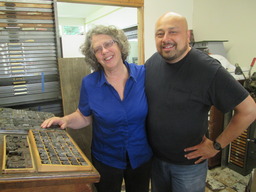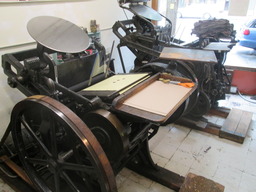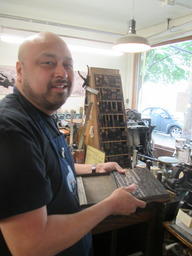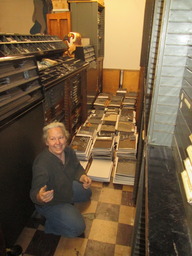
Maralyn and David
 Seattle, USA
Seattle, USA
I was just dropping by for a cup of tea. I hadn't expected a technical, in-depth conversation that will likely influence the direction of my academic writing over the next year. Had I thought about it beforehand I would have realized how the particular friend I was calling on had a far richer knowledge about my thesis topic than I did, myself.
 Maralyn and David |
We often canvassed adjacent census tracts so met on occasion for mid-day dim sum at a restaurant off MLK and Myrtle. We'd gripe about that day's follies of census-taking and contemplate who coule possibly last longer working the operation. Though I've been constantly away from Seattle after that brief time we worked together the two of us retained a casual level contact after the operation completed. I'd call on her and her partner when passing through Seattle. I even managed to attend the opening of an exhibtion displaying a retrospective of her work once while in town.
 David in Print Shop |
"So, do you know the difference between printing presses that use lithography and those that use moveable type?"
I forget which exact words Maralyn chose in responding. They surely wouldn't have been anything so self-assured along the lines of, "Of course I do." However it was she did respond, she quickly brought up the fact that much of her work as an artist has been centered around using an old stone lithographic press. I immediately remembered that on a previous Seattle visit we had once met at an old print shop atop Beacon Hill that still ran letter presses: a place that her friends had established four decades prior. She clearly had far more experience than I did with the topic.
 19th-Century Arabic Typesetting |
I've gotten together with Maralyn twice again (yet far) since that time dropping in for tea. Both of the more recent times we've met have been up at Day Moon Press, her friends' labor of love up on Beacon Hill. When I first came by the print shop last week I was introduced to her friends Jules and Maura--both of whom had been running moveable type presses in that shop for forty years. I gave them a quick summary of my thesis topic then left them to do the rest of the talking, correcting my terminology and showing me examples of what I was supposed to become authority on. An extremely rare double-volume displaying examples of type-setting in the 19th century, including some from my very topic--text in the Arabic script--was retrieved from some special keeping place in the living quarters above the print shop. I couldn't believe what good luck I'd fallen into through a chance re-connection with an old friend.
 Galleys Slotted Beneath Stone |
This morning, I made good on my offer and came by to help. The object at-hand was moving galleys of fonts out from slots beneath a central stone for temporary storage while the shop was being re-arranged. I learnt that sets of solid-lead blocks of individual letters, numbers, and punctuation marks weigh a hell of a lot: I very nearly dropped the tray bearing the first galley out onto the floor as I pulled it out of the slats beneath the stone to port over to where Maura was temporarily stacking them. Sweat as I did, what a great time I had with such good people! Next week, a forklift will come in to do the real moving, transporting old printing presses to the back of the shop and loading one onto a truck to transport to a new venture by a former apprentice.
 Maura Stacks Font Galleys Taken From Central Stone |
I promised Maralyn that I'll stop back in for another cup of tea while I'm stay at Greg's family's home at the end of my Seattle visit later this month. Thank you, dear friend from days of the Census! You've done both me and my upcoming research the most amazing favor just by being you...